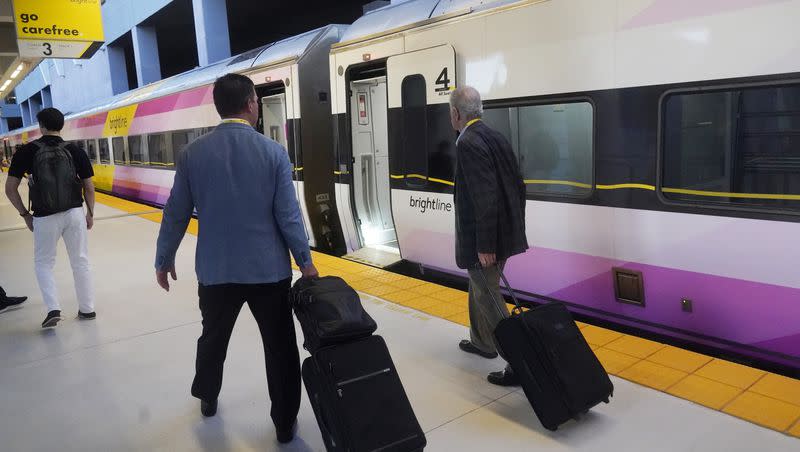Opinion: Backers of a Utah rail line watch carefully as a private train starts in Florida

A California-based company that is looking to build a privately funded passenger rail line connecting Salt Lake City, Las Vegas and Los Angeles is paying close attention to a different private line that began service Friday between Miami and Orlando.
That’s especially true because the Florida company plans to turn its attention next to a Los Angeles-Las Vegas line that could compete with at least part of its plans.
Americans have to go back generations to find the last time train companies competed with each other over major intercity routes. But a lot of people associated with trains believe times are changing, and competition can only mean good things for passengers.
An official close to Dreamstar Lines Inc. of Newport Beach, California — the one hoping to bring trains to Utah — told me the Florida operation, if successful, could confirm the group’s own financial calculations for proposed routes.
“Their success will definitely confirm the market is there for what we’re doing,” said the official, who asked not to be named. That’s true, he said, even though the Florida concept is not identical to what Dreamstar is proposing.
The Florida company, Brightline, was heralded Friday as the first private U.S. passenger rail line to connect major cities in decades. The Associated Press said its trains would travel the 235-mile route between Miami and Orlando in 3.5 hours, which is about 30 minutes less than the average drive time. Trains will run at 79 mph in urban areas, 110 mph in suburban regions and 125 mph through central Florida farmland. Amtrak trains currently run that route in five to seven hours, The Washington Post said.
The Dreamstar line connecting Utah with Los Angeles is proposing a different concept. Its trains would be primarily sleeper cars traveling at slower speeds. The idea is to offer passengers a way to safely travel long distances through the desert, while being able to sleep and take advantage of a dining car.
Dreamstar is currently working on an inaugural Los Angeles to San Francisco route the company hopes to open in 2025. Once that proves viable, the company will turn its attention to the Utah line. It also has hopes to operate trains out of Atlanta, including a line to Orlando. Competition, the company official told me, will serve to form networks that build a synergy for rail service between major cities. Younger Americans — those of the millennial and Gen Z generations — are more likely than their elders to take to rail service.
In a previous interview, the official told me Dreamstar is looking to eventually connect Salt Lake City with Boise and Denver, as well. Meanwhile, the state of Utah is hoping to get a federal grant to begin studying the viability of a Salt Lake City-Las Vegas line.
Brightline’s new Florida line charges between $158 to $298 for round-trip fare. Dreamstar is hoping to keep a Salt Lake to Las Vegas overnight trip to between $200 and $300 one way, with family plans coming in at less than $200 per person. The idea is to replicate the cost of a low-fare flight and a night in a hotel. And yes, the train would stop in St. George and Cedar City.
Brightline hopes to eventually run daytime trains between Los Angeles and Las Vegas at 186 mph by 2028. Dreamstar’s sleeper cars would run at a slower speed, but most of its passengers would be in bed.
Is there room for two companies to service much the same route?
“We think the services are complementary,” the company official said. He added that Brightline is not contemplating a line to Salt Lake City.
The beauty in all of this, of course, is that whether these concepts succeed or fail, it won’t cost taxpayers anything. The Associated Press said Brightline’s owner, Fortress Investment Group, spent $5 billion getting the Miami-Orlando route going. It hopes eventually to serve 8 million passengers.
All you need to know about the difference between a privately funded train line and one that is taxpayer funded can be summed up in a comparison between Brightline’s timeline and that of a proposed publicly funded high-speed California line. As The Associated Press notes, the taxpayer-funded line was approved by voters in 2008, is already billions of dollars over budget and has no estimated date of completion.
Brightline, by comparison, was anxious to begin as quickly as possible to satisfy investors and turn a profit. Its planning began in 2012.
So, will rail service once again become a viable option for Americans traveling 800 miles or less and who are tired of TSA lines and cramped airline seats? Will that service once again make Salt Lake City a crossroads of the West?
Brightline’s chief executive, Michael Reininger, thinks so. He told The Washington Post that the new Florida line is “a moment that marks the beginning of a new industry and a blueprint for expanding rail in America.”
His pocketbook is on the line. The rest of us will just have to wait and see.

